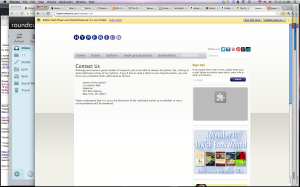Guest post by John Forde
[Note from Shel: I agree with Jack on this. In my 30+ years in business, I’ve been asked to write many complaint letters—and my track record in getting results for my clients and for myself is pretty darn high. I’ve been a subscriber to his newsletter for many years. If you’re a copywriter, I suggest you subscribe as well. He’s both entertaining and useful. Signup info follows his post.]
There was something else that got me thinking about today’s topic. I saw a post over on Copyblogger.com (an amazing site, by the way) about using our copywriting skills to get better customer service.
Their tip focused on help tickets for tech services. But it’s a great insight and one I’ve tapped myself, more than a few times. In fact, I’m a little famous for getting results, among friends and family — enough that I’ve been asked to write “complaint” letters for others.
Not only does a good customer service get problems fixed, it can lead to even more perks. And, I find, all you have to do is follow a simple formula. For instance, I don’t really “complain” in complaint letters. Nor do I get mad or use all-caps or threaten lawsuits or the like. That’s almost always a waste of time.
Instead, I start out with a quick tale of praise and expectation. After all, I say, I bought with the belief that this was the best there was. Almost always, by the way, this is true. Sometimes, I share a little story about why we were excited to make the purchase, too — a birthday, a special trip, to give as a well-deserved gift, and so on.
I’m thinking here, for instance, about a letter I once wrote to Canon, when a video camera failed. It wasn’t just a camera to me. I bought the thing to take video of our son, in his first few days. But the lens jammed so we missed it. From there, I let the seller know that I’m more let down and disappointed than I am angry. I trusted the provider with something important. I believed. And they didn’t deliver. Surely, I allow at this point, it was a one-time mistake… unintentional… and something they could easily fix. Then I tell them how I’d like to see that happen.
In the close, I repeat how much I’m sure they meant to do better… and remind them once again how to go about fixing things, including how to reach me with their solution. I’m not someone to take advantage, but when things have gone wrong, this has almost always worked. For instance, with the Canon camera, I got several personal calls from the head of technical support (yes, he called me) with apologies and attempts at a fix. When we couldn’t get it to work, he gave me an address to send it in. Days later, I got cc-d on a personal email — in Japanese — from the President of Canon, written to his brother in New York, asking him to personally oversee the repair. I kid you not.
I’ve also had the Gap send me $200 in gift certificates and vouchers for four pairs of free pants (this was in the early ’90s) after I bought a defective pair of jeans… We’ve gotten free flight vouchers from two different airlines and courtesy upgrades… Apple has asked me to be on their confidential, early-release program for beta versions of their software… and the list goes on.
Never, ever do I make up a problem where there isn’t one… or pretend it had an impact it didn’t… but when something does go wrong, you’d better believe that copywriting can help solve it.
Sign up for Jack’s newsletter, and get $78 worth of gifts, at https://copywritersroundtable.com





